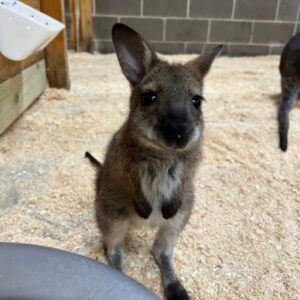Description
Discover the Fascinating Monitor Lizard: A Unique Exotic Pet Option
Monitor lizards are among the most intriguing and majestic reptiles you can consider as an exotic pet. Known for their intelligence, striking appearance, and unique behaviors, these creatures are a favorite among reptile enthusiasts. However, owning a monitor lizard is a significant commitment that requires specialized care, a proper environment, and a deep understanding of their needs. At ExoticPetsCare.com, we’re here to guide you through everything you need to know about adopting and caring for a monitor lizard.
Introduction to Monitor Lizards
Monitor lizards belong to the genus Varanus and are found in Africa, Asia, and Australia. With over 80 species, they range in size from the small 8-inch dwarf monitors to the massive Komodo dragon, which can grow up to 10 feet long. Popular species kept as pets include the Savannah monitor, Ackie monitor, and Asian water monitor. These reptiles are known for their keen intelligence, strong limbs, and long, forked tongues used for sensing their environment.
Physical Characteristics
Monitor lizards are easily recognizable by their distinctive features:
- Size: Depending on the species, they can range from 1 to 10 feet in length.
- Appearance: They have muscular bodies, long necks, and powerful tails. Their scales are often patterned with spots, stripes, or bands.
- Tongue: Their forked tongues are used to “taste” the air, helping them locate prey and navigate their surroundings.
- Claws and Teeth: Monitors have sharp claws for climbing and digging, and their teeth are designed for gripping and tearing prey.
Behavior and Temperament
Monitor lizards are highly intelligent and curious reptiles. They are active during the day (diurnal) and enjoy exploring their environment. While some species can be docile and tolerate handling, others are more skittish or aggressive. Proper socialization from a young age is crucial to building trust with your monitor lizard. Keep in mind that these are wild animals with strong instincts, and they may not always behave predictably.
Care Requirements for Monitor Lizards
1. Housing
Monitor lizards need spacious enclosures that mimic their natural habitat. For larger species, custom-built enclosures or dedicated rooms may be necessary. The enclosure should include:
- Substrate: A mix of soil, sand, and coconut fiber for digging and burrowing.
- Climbing Structures: Branches, rocks, and platforms for climbing and basking.
- Hiding Spots: Caves or logs to provide security and reduce stress.
- Water Feature: A large water dish or pool for soaking and swimming (especially for semi-aquatic species like the Asian water monitor).
2. Diet
Monitor lizards are carnivorous and require a varied diet:
- Protein Sources: Insects, rodents, fish, and occasionally eggs or small birds.
- Supplements: Calcium and vitamin supplements to prevent nutritional deficiencies.
- Feeding Frequency: Younger monitors need daily feeding, while adults can be fed every 2-3 days.
3. Temperature and Lighting
Monitors are ectothermic, meaning they rely on external heat sources to regulate their body temperature. Provide:
- Basking Spot: A temperature of 90-120°F (depending on the species).
- Cool Zone: A cooler area around 75-85°F.
- UVB Lighting: Essential for calcium absorption and overall health.
4. Enrichment and Social Needs
Monitor lizards are intelligent and need mental stimulation. Provide toys, puzzles, and opportunities to explore outside their enclosure (under supervision). While they are solitary animals, they can form bonds with their owners through consistent interaction.
Legal Considerations
Before adopting a monitor lizard, research local laws and regulations. Some species are protected, and permits may be required. Always ensure your monitor lizard is sourced ethically and legally.
Why Adopt a Monitor Lizard?
Monitor lizards are fascinating pets for experienced reptile keepers. Their intelligence, unique behaviors, and striking appearance make them a rewarding companion. However, they require a significant commitment of time, resources, and expertise. If you’re ready to provide the care they need, a monitor lizard can be a truly extraordinary addition to your life.
Interesting Facts About Monitor Lizards
- Monitor lizards are among the most intelligent reptiles, capable of problem-solving and learning routines.
- Some species, like the Komodo dragon, have venomous saliva that helps subdue prey.
- Monitors use their tails for defense, balance, and even swimming.
- They are excellent climbers and diggers, making them highly adaptable to various environments.
Conclusion
Adopting a monitor lizard is a unique and rewarding experience, but it comes with significant responsibilities. These intelligent and captivating reptiles require specialized care, a proper environment, and a dedicated owner. If you’re prepared to meet their needs, a monitor lizard can be a fascinating and lifelong companion.
At ExoticPetsCare.com, we’re here to help you every step of the way. Contact us today to learn more about adopting a monitor lizard and to explore other exotic pet options available to you.







Reviews
There are no reviews yet.